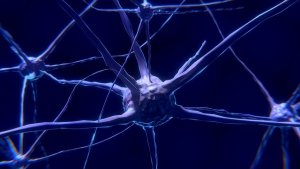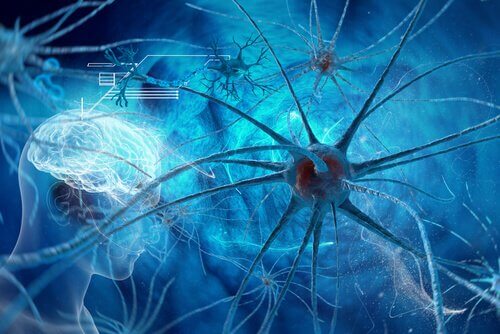Neurons: What They Are and How They Work

Before we go any further, one thing you have to know is that all neurons have the same genetic information as the rest of the cells in your body. They also have the same basic elements in their structure (membrane, nucleus, organelles, etc).
What makes them so special compared to other cells is the place they occupy in our neural networks. This is what lets them carry out basic processes like receiving, processing, and sending information.
To understand what a neuron is, we have to learn about its structure and its synaptic functions. Both of those things will help you understand why they group together the way they do, and how they send information throughout your brain. So today we’re going to talk about the structure of a neuron and a synapse.

The structure of a neuron
Even though there are many types of neurons with different structures, there are still some common elements. The normal structure is made up of three basic parts: the soma, the dendrites, and the axon. This makeup helps them fulfill their roles as connectors and information managers.
Before we explain the three parts, it’s also worth mentioning one strange thing about a neuron’s membrane. It’s not permeable in the exact same way as the other cells in your body. In fact, that’s what enables it respond to the stimuli around it. That’s why the electric impulse created in a neuron can travel to other cells or tissues.
The parts of a neuron
The central part of a neuron is the soma. It’s where all the metabolic activity happens. The soma is where the nucleus is, along with other microstructures and cellular organs that keep neurons alive.
The dendrites are the branches that come out from the soma and make it look like a tree. These are primarily where the information reception happens. Dendrite trees have forks that connects one neuron to the axons in other neurons and communicate with them.
Neurons can transmit information because the dendrites have neuroreceptors all along their membrane. Even though the communication is mostly axon-dendrite, there can be other kinds too (axon-axon or axon-soma).
The axon comes out of the soma from the wider part that we call the “axon hillock.” What it does is incorporate the information taken in by the neuron so it can transmit it to other ones later. At the very end of an axon are the axon terminals. They connect to the dendrites of other neurons.

Synapses, or neural communication
Once you understand what the structure of neurons is like, you have to understand how they communicate with each other. They communicate with each other through synapses. The communication usually happens through an axon-dendrite connection, but like we mentioned, it can happen other ways too.
On a morphofunctional level, the communication can either happen with a chemical synapse or an electrical one. While there are many different electrical synapses, especially in smooth muscle tissue, most synapses in a mammal’s nervous system are the chemical kind.
Structures that we call connexins are involved in electrical synapses. They are ionic channels that bring neurons together and make it possible for an electrical current to run between them.
The advantage of this synapse compared to the chemical kind is that it sends information much faster. The bad side is that the quality and capacity of the information is much lower than with the chemical kind.
With chemical synapses, there are substances we call neurotransmitters or neuromodulators (like dopamine). The part of the neuron that stores these substances is the axon terminal, and they wait there until they get the order to go out.
Once they unhook from the interstitial space between two neurons, these neurotransmitters hook onto certain receptors that regulate neural activity. We have a large variety of neurotransmitters, and every one of them works differently and has a different effect.
A deeper study of neuron structures and synapses can help explain these processes. And thanks to research, neuroscience has been able to dig quite deeply into the neural mechanisms for learning, perception, emotion, and much more.
Before we go any further, one thing you have to know is that all neurons have the same genetic information as the rest of the cells in your body. They also have the same basic elements in their structure (membrane, nucleus, organelles, etc).
What makes them so special compared to other cells is the place they occupy in our neural networks. This is what lets them carry out basic processes like receiving, processing, and sending information.
To understand what a neuron is, we have to learn about its structure and its synaptic functions. Both of those things will help you understand why they group together the way they do, and how they send information throughout your brain. So today we’re going to talk about the structure of a neuron and a synapse.

The structure of a neuron
Even though there are many types of neurons with different structures, there are still some common elements. The normal structure is made up of three basic parts: the soma, the dendrites, and the axon. This makeup helps them fulfill their roles as connectors and information managers.
Before we explain the three parts, it’s also worth mentioning one strange thing about a neuron’s membrane. It’s not permeable in the exact same way as the other cells in your body. In fact, that’s what enables it respond to the stimuli around it. That’s why the electric impulse created in a neuron can travel to other cells or tissues.
The parts of a neuron
The central part of a neuron is the soma. It’s where all the metabolic activity happens. The soma is where the nucleus is, along with other microstructures and cellular organs that keep neurons alive.
The dendrites are the branches that come out from the soma and make it look like a tree. These are primarily where the information reception happens. Dendrite trees have forks that connects one neuron to the axons in other neurons and communicate with them.
Neurons can transmit information because the dendrites have neuroreceptors all along their membrane. Even though the communication is mostly axon-dendrite, there can be other kinds too (axon-axon or axon-soma).
The axon comes out of the soma from the wider part that we call the “axon hillock.” What it does is incorporate the information taken in by the neuron so it can transmit it to other ones later. At the very end of an axon are the axon terminals. They connect to the dendrites of other neurons.

Synapses, or neural communication
Once you understand what the structure of neurons is like, you have to understand how they communicate with each other. They communicate with each other through synapses. The communication usually happens through an axon-dendrite connection, but like we mentioned, it can happen other ways too.
On a morphofunctional level, the communication can either happen with a chemical synapse or an electrical one. While there are many different electrical synapses, especially in smooth muscle tissue, most synapses in a mammal’s nervous system are the chemical kind.
Structures that we call connexins are involved in electrical synapses. They are ionic channels that bring neurons together and make it possible for an electrical current to run between them.
The advantage of this synapse compared to the chemical kind is that it sends information much faster. The bad side is that the quality and capacity of the information is much lower than with the chemical kind.
With chemical synapses, there are substances we call neurotransmitters or neuromodulators (like dopamine). The part of the neuron that stores these substances is the axon terminal, and they wait there until they get the order to go out.
Once they unhook from the interstitial space between two neurons, these neurotransmitters hook onto certain receptors that regulate neural activity. We have a large variety of neurotransmitters, and every one of them works differently and has a different effect.
A deeper study of neuron structures and synapses can help explain these processes. And thanks to research, neuroscience has been able to dig quite deeply into the neural mechanisms for learning, perception, emotion, and much more.
This text is provided for informational purposes only and does not replace consultation with a professional. If in doubt, consult your specialist.







